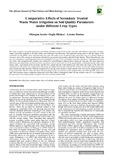Comparative effects of secondary treated waste water irrigation on soil quality parameters under different crop types

View/
Date
2011Author
Areola, O.
Dikinya, O.
Mosime, L.
Publisher
Global Science Books, http://www.globalsciencebooks.info/Journals/AJPSB.htmlType
Published ArticleMetadata
Show full item recordAbstract
This study compares soil quality parameters, and salinity and heavy metal levels in soils cultivated with different crops under secondary treated wastewater irrigation in the Glen Valley, near Gaborone City, Botswana. The hypothesis being tested is that the impact of wastewater on soil quality varies with soils and crop types. The study covers 4 selected crops, maize (Zea mays L.), spinach (Spinacia oleracea), olive (Olea europaea), and tomato (Solanum lycopersicum), most widely cultivated by the farmers. Three farm plots per crop type were sampled at 5 sampling points and at two soil depths, 0-15 and 15-30 cm. Samples were also collected at 5 sampling points from two control sites. Irrigation water samples were collected from microbiological analysis from 2 farms per crop type. The most significant differences and relationships are between those crop farms, such as maize and two of the spinach plots, with predominantly sandy soils (loamy sands – sand loams) on the one hand, and the olive, tomato and one of the spinach plots with sandy clay loams on the other. The importance of soil texture was confirmed by the strong correlations between the sand and silt contents, several soil quality parameters, heavy metals and other elements. With the exception of Cd and Hg, most soil heavy metal contents were lower on the irrigated plots than on the control plot. The EC values also show that soil salinity levels were still low on the irrigated fields, but SAR and ESP values were high. The secondary treated wastewater being used in the Glen Valley is biologically clean, but one recorded case of E. coli emphasizes the importance of avoiding sprinkler irrigation at all costs to protect human health.
